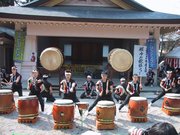Taiko
|
|
The word taiko (太鼓) means simply "great drum" in Japanese. Outside Japan, the word is often used to refer to any of the various Japanese drums (和太鼓, 'wa-daiko', "Japanese drum", in Japanese) and to the relatively recent art-form of ensemble taiko drumming (sometimes called more specifically, "kumi-daiko" (組太鼓).
| Contents |
Types of taiko
Taiko_drum_manufacturing.jpg
The nagado-daiko (長胴太鼓, long-body taiko) consists of two pieces of cow hide stretched over a wooden body (traditionally carved from a single piece, now often made from the stays of a barrel) and tacked to high tension. The heads of the tsukeshime-daiko (付締め太鼓, often shortened to simply, "shime-daiko" or "shime") are stretched over iron rings and sandwiched around a smaller body. The tsukeshime-daiko's rope is pulled tight before each use. The okedo-daiko (桶胴太鼓, barrel-body taiko, often shortened to "okedo" or "oke") can be set on a stand and played like other taiko, but is usally strapped over the shoulder so the drummer can walk and play at the same time. Other Japanese taiko include the uchiwa-daiko (内輪太鼓、fan taiko), hira-daiko (平太鼓, flat taiko), o-daiko (大太鼓, big taiko), and a host of percussion instruments used in Japan's traditional noh, gagaku, and kabuki ensembles.
Giant_Taiko_Drum_Nagoya.jpg
The okedo-daiko drums range from small and easy to carry, up to the largest drum of all Japanese drums. Unlike the nagado, this drum can be made in many sizes but NOT in any size due to its stave wooden construction.
The Aomori region is famous for the Nebuta festival where huge okedo are played by many people while carted through the streets. The Okedo has its own betta stand which was invented by Hayashi Eitetsu.
Again, like the nagado-daiko, the okedo has a rim sound, called "ka." When playing the rim of an okedo, however, it is important to only hit the outermost metal ring and not the actual rim of the drum body. The thin, light wood of the okedo is particularly susceptible to denting and will quickly deteriorate if hit.
Uses of the Taiko in Warfare
In feudal Japan, taiko were often used to motivate troops, to help set a marching pace, and to call out orders or announcements. Approaching or entering a battle, the taiko yaku (drummer) was responsible for setting the marching pace, usually with six paces per beat of the drum (beat-2-3-4-5-6, beat-2-3-4-5-6).
According to one of the historical chronicles (the Gunji Yoshu), nine sets of five beats would summon an ally to battle, while nine sets of three beats, sped up three or four times, and followed by the cry "Ei! Ei! O! Ei! Ei! O!" is the call to advance and pursue an enemy.
Related Terms
- Bachi
- the wooden sticks used to play taiko drums. (See separate entry for additional details.)
- Ji
- also called Jiuchi, it is a basic rhythm used to support the main rhythm, or the O-uchi. It can also be described as the meter or feel of a piece (being in a straight duple meter or having a swing feel). Some of the more common rhythms for ji are don doko, don ko, or don go (swing pattern). A Jikata is a performer who plays the ji rhythm.
- Ma
- a Japanese term for "space", it is used in music to describe a period of silence. In taiko drumming, ma is the period between hits on the drum. It is important to appreciate this silence when playing taiko, just as you would appreciate the sound of a hit on the drum. Since ensemble taiko is focused on rhythm, the ma of a piece is critical to adding drama, excitement, and tension. Ma can be a rhythmic rest, or an extended silence, to be broken at the player's discretion. If the player concentrates on hearing the ma between each hit, in addition to the hits themselves, he or she will create a much more effective and satisfying sound. A good example of how ma is used is in oroshi.
- Oroshi
- is characterized by a series of hits on the taiko. The player starts out slowly with lots of ma. Gradually the ma (time) between each hit becomes shorter and shorter, until the drummer is playing a rapid roll of hits.
See also
- Music of Japan for some history of taikos.
- Kuchi shoga, a system used to 'pronounce' taiko sounds.
- Kodo is a world famous and popular music group that performs using traditional Japanese instruments, primarily taiko.
- Taiko: Drum Master (aka Taiko no tatsujin) is a drumming game for the PlayStation 2
External link
- Rolling Thunder Website (http://www.taiko.com)
- Kumidaiko.com - Taiko News (http://www.kumidaiko.com)
Other Uses of the Term (non-drum related)
The unrelated word Taikō (太閤) is a title given to a retired Sessho and Kampaku regent in Japan. In a narrow sense, taikō would refer to Toyotomi Hideyoshi, a more common usage. Template:Commonsde:Taiko es:Taiko he:טאיקו ja:和太鼓 pt:Taiko

